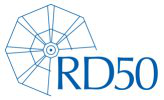Speaker
Description
The CMS detector will be upgraded to face a 10-fold increase in integrated luminosity for the High-Luminosity LHC era. Its endcap calorimeters will be replaced by the high-granularity calorimeter (HGCAL). With its unprecedented transverse and longitudinal readout/trigger segmentation, with more than 6M readout channels, HGCAL will facilitate the use of particle-flow calorimetry. Silicon pad sensors will be used for high radiation regions, covering a total area of 620 m$^2$, where it is expected to reach integrated neutron fluences of $10^{16}$ neq/cm$^2$ and doses of 1.5 MGy. The silicon sensors are processed on 8-inch wafers with three different thicknesses (300, 200, 120 $\mu$m), and cut into hexagonal shape for tiling and for optimal use of the wafer area. Each sensor is segmented into several hundred cells of hexagonal shape of 0.5 to 1.1 cm$^2$ in size, each of which is read out individually. In addition to the main sensors, the full wafer hosts small sized test structures used for quality assurance and radiation-tolerance tests. The talk will focus on radiation-tolerance studies performed with the hexagonal 8-inch sensors irradiated to fluences up to 10$^{16}$ neq/cm$^2$ at the novel neutron irradiation facility at Rhode Island Nuclear Science Center (RINSC, US). Using the ARRAY system (a customised probe and switch card system), their electrical properties in terms of pad leakage currents and capacitances have been measured for the first time, after neutron irradiation both without and with additional beneficial annealing. We present the results of those measurements, hereby qualifying the RINSC neutron irradiation facility and showing that the measured electrical properties of the HGCAL silicon sensors after irradiation meet expectations.
